
Posts Tagged: urbanag
Does Urban Agriculture Improve Food Security?
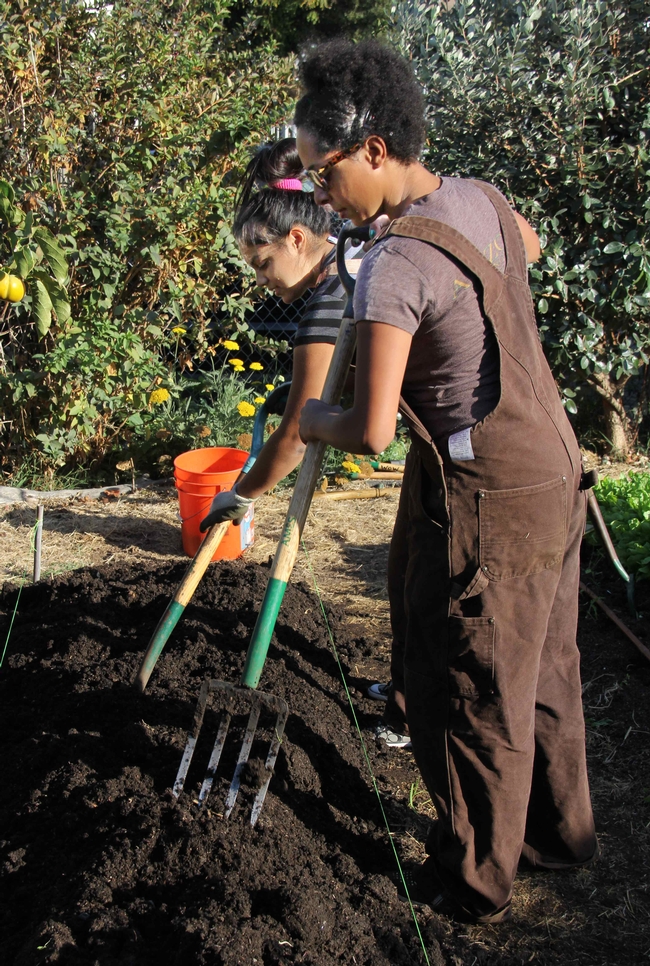
Without understanding the actual links between UA and food security or which specific characteristics, models or approaches reduce insecurity, urban policymakers and advocates risk backing policies that could have unintended consequences or negative impacts on vulnerable individuals and communities. We argue that in addition to more robust analyses that measure the actual social, economic, and health impacts of urban agriculture, and how they impact food security, it is important to understand which approaches to policy, governance and civic engagement support UA models that are effective in reducing food insecurity.
In general, we see three trends in current scholarship on UA in relation to community food security: (1) a focus on the production potential of urban lands, (2) individual case studies highlighting various nutritional, health, and other community benefits or outcomes from urban gardening initiatives, and (3) more critical analyses of UA through food justice and equity lenses. To this latter point, robust theoretical analyses have emerged critiquing the risks of UA when approached without an equity lens, potentially reinforcing structural injustices and racism and negatively impacting communities that ideally should benefit the most.
Deeper historical and structural challenges including poverty, racism, and divestment in specific communities and neighborhoods are increasingly being recognized as the root causes of the problem of unequal access to sufficient supplies of safe, nutritious, affordable, and culturally acceptable food facing cities. Designating land for agricultural use in urban areas may conflict with other city planning priorities around affordable housing, community economic development, or smart growth approaches associated with reducing urban sprawl and mitigating climate change, such as transit-oriented development. Because of the persistent legacy of systemic discrimination, it is neither inevitable nor guaranteed that urban agriculture will redress food system inequities; in fact, urban farms can sometimes lead to displacement through eco-gentrification. This is a particularly acute concern in areas experiencing housing pressures and population growth, such as the San Francisco Bay area and New York City.
Analyzing the intersection of food access and food distribution literatures reveals three key factors mediating the effect of UA on food security in the urban food system:
(1) the economic viability of urban farms (to sustain the provisioning of affordable urban produced foods)
(2) the role of city planning and policies in advancing racial equity through UA such as secure land tenure and public investment, and
(3) the importance of civic engagement to advocate for and hold cities and counties accountable to the needs of low-income communities.
We highlight examples from both the scholarly and gray literatures that demonstrate how UA can improve food access, distribution, and justice, in a way that supports both consumers and producers of food in cities. The gray literature in particular reveals many emerging and informal distribution networks for urban produced foods that would benefit from further academic study, such as gleaning networks, distribution apps, and online platforms.
The review concludes with a set of recommendations for researchers, practitioners, and policymakers who seek to create spaces in cities for food justice, equity, access, and sovereignty. Most notably we acknowledge that urban farms are producing a lot more than food; and that equitable planning, public investment and civic engagement are crucial elements in securing the long-term viability of urban farms. More robust analyses documenting the multifaceted benefits and risks of UA such as public health, food security, youth development, food literacy, eco-gentrification and environmental justice can help inform more equitable public policy and planning efforts.
Home is where the habitat is: This Earth Day, consider installing insectary plants
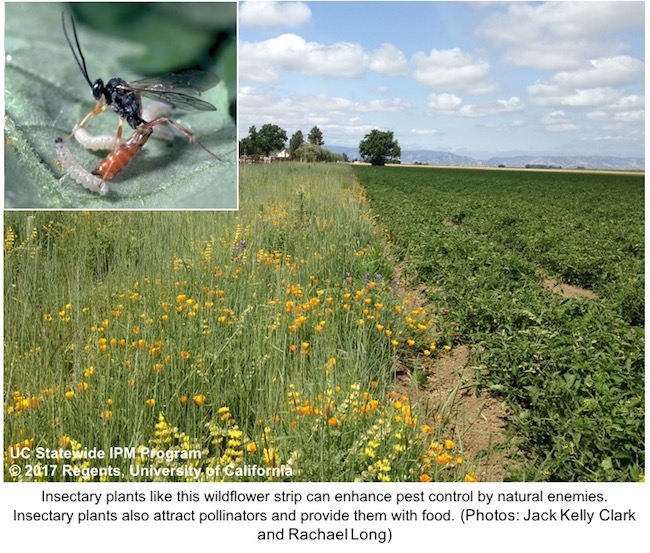
Flowering insectaries also provide food for bees and other pollinators. There are both greater numbers and more kinds of native bees in fields with an insectary consisting of a row of native shrubs planted along the field edge (called a hedgerow). Native bees also stay in fields with these shrubs longer than they do in fields without them. Therefore, not only do insectaries attract natural enemies, but they can also boost crop pollination and help keep bees healthy.
Sources:
- Flower flies (Syrphidae) and other biological control agents for aphids in vegetable crops. (PDF)
- Good news for hedgerows: no effects on food safety in the field.
- Hedgerow benefits align with food production and sustainability goals.
- Habitat restoration promotes pollinator persistence and colonization in intensively managed agriculture. (PDF)
- Reducing the abundance of leafhoppers and thrips in a northern California organic vineyard through maintenance of full season floral diversity with summer cover crops.
August 19th is National Honey Bee Day: Dr. Elina Niño reminds us to help honey bees cope with pests
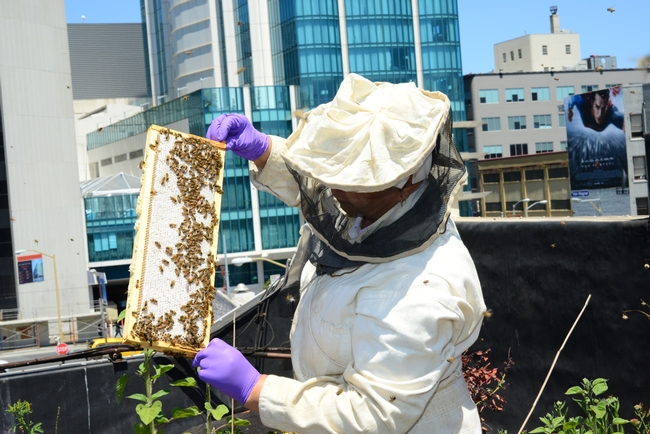
https://soundcloud.com/ucipm/help-honey-bees-cope-with-pests
To read the full transcript of the audio, click here.
Successful IPM in honey bee colonies involves understanding honey bee pest biology, regularly monitoring for pests, and using a combination of different methods to control their damage. Visit these resources for more information:
Sources for the Value of Honey Bees:
Flottum K. 2017. U.S. Honey Industry Report, 2016.
Urban Farming and Water Conservation: A Way of Life on the City Farm
Reyna Yagi (ryagi@ucanr.edu), Northern California Urban Agriculture Program Coordinator, University of California Cooperative Extension - Alameda and Contra Costa Counties
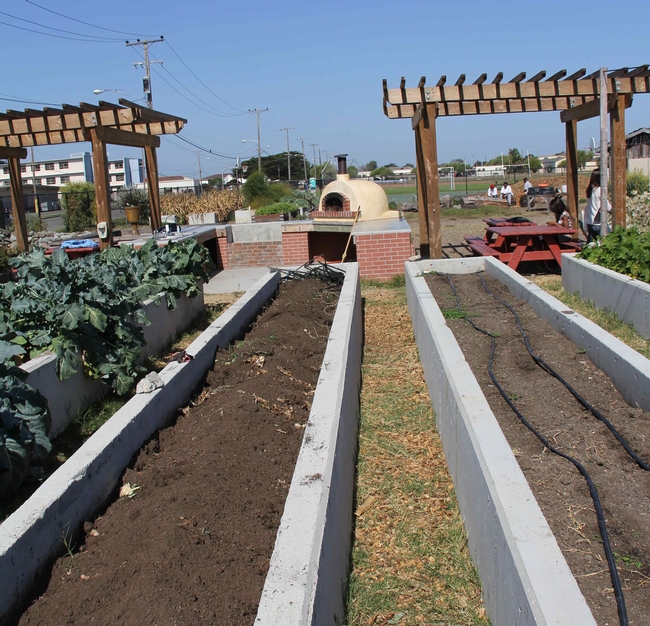
How can we as urban farmers do our part to conserve water? Turns out there are a lot of ways that not only will help to save our beautiful state's water, but also help you build a healthier farm or garden with less work on your hands!
Tip Sheet: Building Fertile Soil – Center for Agroecology and Sustainable Food Systems UC Santa Cruz
Tip Sheet: Your Food Garden During Drought – UC Master Gardener Program Contra Costa County
Tip Sheet: Drip Irrigation – Installation and Maintenance – UC Master Gardener Program of Sonoma County
-
Rainwater Harvesting allows you to capture rainwater from roofs, collect it in a cistern for diversion to your landscape for supplemental irrigation. You should also observe your site's water runoff patterns and see how you can manage and maximize your runoff to deal with large rain events, stormwater runoff and infiltration around your site. Consider a rain garden!
Tip Sheet: Rainwater Harvesting – UC Master Gardeners of Nevada County
- Dry Farming depends on the water stored in the soil from winter rains that plants can use in the spring as the weather warms. Plants rely on good soil moisture and deep roots to seek out this extra water without needing much supplemental irrigation. Grapes, potatoes, tomatoes, winter squash, fruit trees and grains can be dry-farmed.
Tip Sheet: How to Dry Farm Tomatoes in Contra Costa – UC Master Gardener Program – Contra Costa County
And Remember:
- Deep watering wets entire root zones which promotes deeper root growth.
- Always water early in the morning to prevent daytime water loss through evaporation.
- Keep an eye on the weather! A refreshing rain or cool, cloudy day will extend the time between watering.
- Maintenance, maintenance, maintenance. Visually inspect your drip system regularly for breaks, leaks and missing pieces. If you don't, your plants will certainly let you know with plant diseases.
California's agricultural industry is the largest in the nation and abroad, carrying with that a great responsibility to protect and conserve our resources. Urban farmers are highly cognizant of this. They are some of the most innovative and conservation-minded folks out there who understand the fragility of our water supply and their role in being model stewards of our lands and waters.
Urban Farm Spotlight: GrowGood
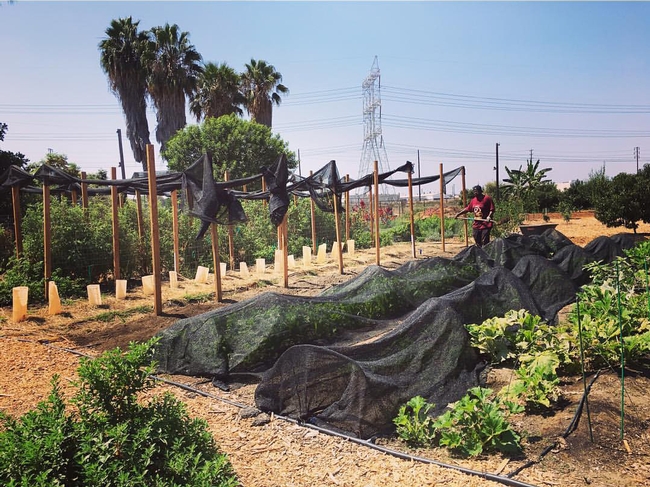
GrowGood is a Los Angeles-based non-profit urban farm with a mission to create urban agricultural programs that empower people and transform communities. Created in 2011 by Brad Pregerson and Andrew Hunt, GrowGood has worked with The Salvation Army's Bell Shelter to convert the vacant site adjacent to the shelter into an urban farm. The Bell Shelter is the largest homeless shelter west of Mississippi that provides a comprehensive transitional care program for up to 350 homeless men and women, many of them veterans.
GrowGood accomplishes its mission through three main strategies: (1) supplying a variety of nutritious, fresh produce to the Shelter's kitchen; (2) providing job training and meaningful resume-building employment opportunities for homeless and other vulnerable populations with the greatest barriers to employment; and (3) managing a therapeutic green space for spiritual and emotional healing.
Despite having been neglected for many years, GrowGood's soil biology has improved remarkably with time, patience, and beneficial cover crop seed mixes. GrowGood maintains organic practices without using chemical fertilizers, pesticides, or herbicides. The farm enriches its soil with compost and worm tea made on-site.
Most of what GrowGood produces goes to the shelter, including vegetables, herbs, and fruit, but you can also find their bounty in local Los Angeles restaurants.
Whether it's providing employment, providing nourishment, or hosting a community workshop – GrowGood has it all, and proves you don't need much space to “grow good.”
Learn More
Website:GrowGood
Social Media Links
Email: jayne@grow-good.org
Phone: (323) 645-0215
